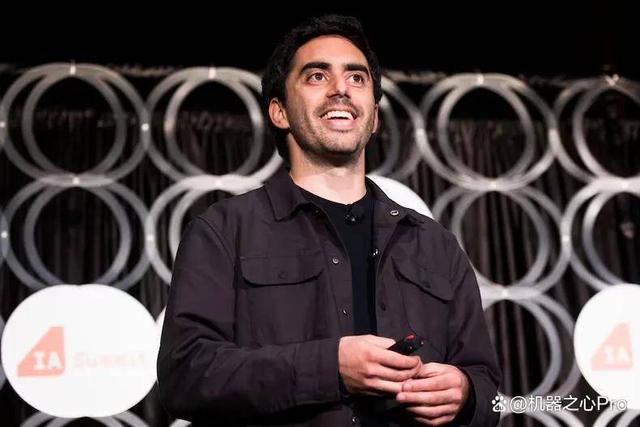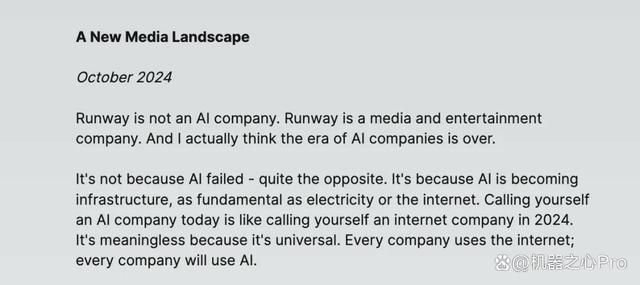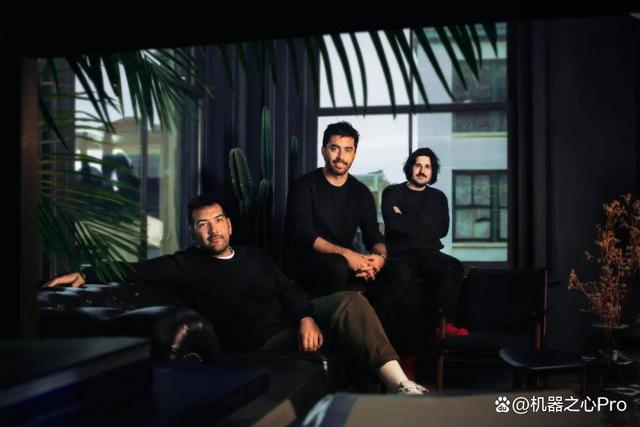This year's big models were extremely lively in the first half of the year, but a little cool in the second half.
Doing low-level large-scale model research and development is like a long-lasting marathon, with high research and development costs, high technical thresholds, and fierce iteration competition. Take OpenAI, for example, its annual losses from research and development are as high as $5 billion. Such financial pressure is obviously not something that ordinary AI companies can bear. AI startups also tend to be very pragmatic, always considering commercialization and profit realization as core considerations.
AI is on the road to finding its own uses, and video generation can be regarded as one of the tracks closest to application. However, today, the CEO of Runway, the “top-tier” company that generates AI videos, “sentenced death” to the AI company. In his open letter, the first paragraph reads: "I think the era of AI companies is over."

Runway co-founder and CEO Cristóbal Valenzuela Barrera
The full text of the letter is as follows:
Runway is not an AI company. Runway is a media and entertainment company. In fact, I think the era of AI companies is over.

This is not because AI has failed—quite the opposite—but because AI is becoming an infrastructure like electricity or the Internet. Calling yourself an AI company today is like calling yourself an Internet company in 2024. It doesn't make sense because everyone is using it -- every company uses the Internet; every company will use artificial intelligence.
For Runway, our focus is on the arts, media and wider entertainment sectors. The vision we started Runway seven years ago remains unchanged: artificial intelligence is an essential tool for storytelling. To realize this vision, we had to do the opposite and build the best research team to deliver the best models to support the best products.
I often liken our work to a new kind of "camera." The “camera” here does not literally capture images, but rather refers to a longer-term historical scale. The camera didn't just create photography—it gave birth to entire industries, economies, and art forms. Movies, TV, TikTok — all started with that revolutionary tool that captured light and time.
I think Runway's job is laying the groundwork for a whole new media landscape. Just like cameras changed the way we capture reality, artificial intelligence is changing the way we create reality. The models and technologies Runway has built are just the beginning - they are the equivalent of those original daguerreotypes, raw but full of possibilities.

Daguerreotype is an early photography technique invented in 1839 by Frenchman Louis Daguerre.
Many people mistakenly view artificial intelligence as the ultimate goal. They are wrong. AI is just a tool and a way to support greater achievements. The real revolution lies not in the technology itself, but in what it can enable: pioneering new forms of expression, unlocking new ways of telling stories, and finding new ways to connect to the human experience.
Traditional media is like a one-way street. Creations flow to consumers through established channels. Even if distribution is disrupted first by social media and then by streaming media, the basic model still exists: Some people create, others consume. Roles are clear and boundaries are clear. However, now we are witnessing a completely new situation.
Imagine that the show you are watching is automatically generated as you watch it - truly dynamic content that responds to you, understands you, and is completely tailored to you. Analog worlds that allow content to shape itself in real time can dissolve the boundaries between creation and distribution. This is not only the basis for building a new media landscape, but will also fundamentally redefine media: it is interactive, generative, and personalized, but also shared and universal.
This is why pure AI companies are becoming obsolete. The fundamental question that needs to be answered now is no longer simply technology - but what can we create with technology? The next wave of innovation will not come from companies that focus on research models. Models have become a commodity. The technical foundation is now solid and there are no secrets in the industry. Real change will come from those who know how to use these tools to create new media forms, new experiences, and new narratives. The infrastructure has been laid, and the next step is to use AI to create meaningful things.
The end of AI companies marks a new beginning: the birth of a new media. This isn’t just a new platform or format, it’s a whole new way of creating and experiencing content. We are no longer committed to building an AI company. This is a more exciting mission, just like what Runway has always been pursuing: returning to our original intention.
"Horse-catching" Runway
Runway was founded in 2018. Founder and CEO Cristóbal Valenzuela Barrera believes that artificial intelligence has great potential in the field of artistic creation. Therefore, Runway has been committed to providing tools and platforms for designers, artists and developers since its inception.

Runway’s founding team: from left to right: Alejandro Matamala, Cristóbal Valenzuela Barrera, AnastASIs Germanidis
Looking back at the development history of Runway, we will find some "horse-grabbing" incidents: the teams behind Stable Diffusion were at odds with each other, and the HuggingFace library was suddenly deleted...
When Stable Diffusion is mentioned today, we may think that it is the research work of Stability AI, but in fact, the technical source of this model is a paper "High-Resolution Image Synthesis with Latent Diffusion Models" published in CVPR 2022, signed There are five authors in total, from Munich University, Heidelberg University and Runway. In 2022, Runway officially announced the release of Stable Diffusion v1.5, and had conflicts with Stability AI over Stable Diffusion copyright issues.

At the end of August this year, Runway suddenly deleted and cleared all their content on HuggingFace, including Stable Diffusion v1.5. On the Hugging Face homepage, Runway states that it no longer maintains HuggingFace.
Although these incidents are somewhat confusing, Runway has continued to make efforts in the field of visual generation. For example, Gen-3 Alpha, a video generation basic model recently launched by Runway, can create high-definition videos with complex scene changes, multiple movie styles and detailed art guidance.
Recently, Gen-3 Alpha also released a new feature - Act-One, which allows users to upload a video to drive the video character to make the same expressions and actions, which can be said to have subverted the motion capture industry.
If "the era of AI companies is over," then Runway seems to have been creating tools and value in the arts, media, and broader entertainment fields. Perhaps, as the CEO said, AI will be an infrastructure in the future, and what is more worth thinking about and exploring is the application direction of AI.
Do you agree with Runway CEO’s views?